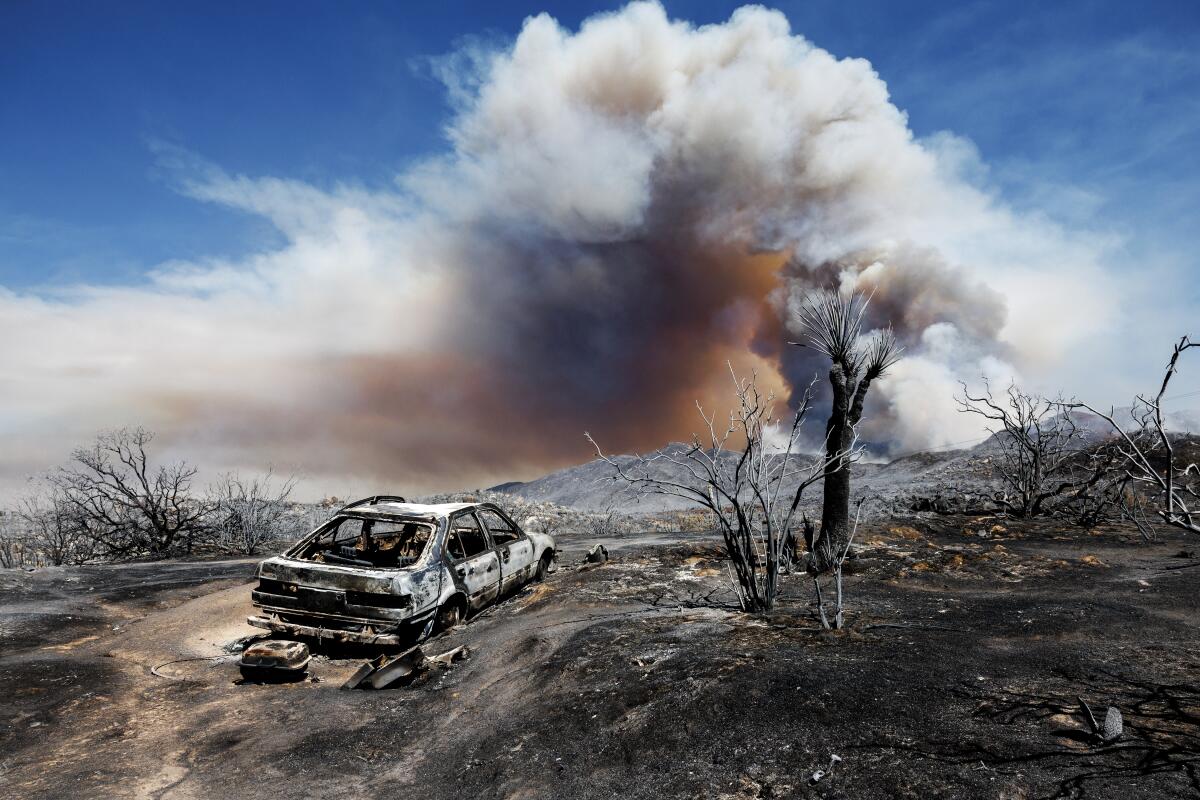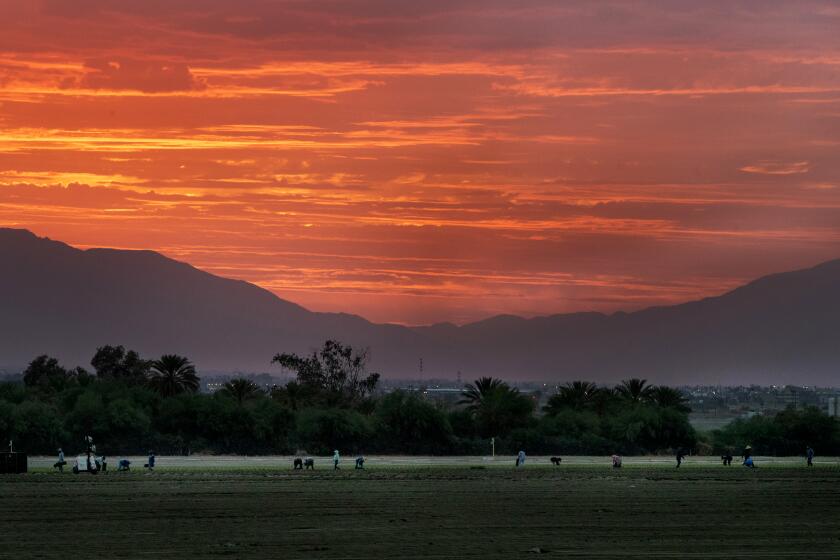July was California’s hottest month ever, as climate warms to dangerous new extremes

- Share via
The month of July kicked off with a dire warning: A rare, long-duration heat event was forecast to bring extreme heat risk across the West, with triple-digit temperatures and dangerous fire conditions expected in much of California for days on end.
That outlook quickly proved accurate — and would end up defining almost the entire month in the Golden State, which would see little relief from unrelenting heat.
As the first heat wave kicked off, utility officials on July 2 initiated the year’s first planned power shutoffs in some Northern California counties, trying to avoid dangerous fire starts in the scorching weather.
Then, record after record across the state shattered. Palm Springs saw its hottest day ever, hitting 124 degrees July 5. Redding hit an all-time high of 119 degrees July 6. Palmdale and Lancaster had almost a week straight of days at or above 110 degrees, more than doubling the cities’ previous streaks.
Tragic outcomes, too, began to mount. Several wildfires that erupted in the extreme heat destroyed homes and sent families fleeing. A motorcyclist died while touring Death Valley.
Without much of a reprieve, a second heat wave then broiled the state’s interior. While not as intense or as long as the first, it would still fuel the Park fire’s explosive growth across Butte and Tehama counties. Within a matter of days, the blaze would become one of the largest wildfires in California history.
It was a historic month for extreme heat, and now climate data have confirmed just how unprecedented it was: July 2024 was officially California’s hottest on record.
The heat wave will last through at least through Tuesday of next week, with triple-digit temperatures expected for much of Northern and Central California.
July’s average temperature across the Golden State was 81.7 degrees, surpassing the prior record from July 2021 by almost two degrees, according to data published Thursday by the National Centers for Environmental Information, a division of NOAA. The agency’s statewide climate data goes back to 1895.
“July’s heat was remarkable not only for its sheer intensity ... but also for its duration,” Daniel Swain, a UCLA Climate Scientist wrote in a blog post anticipating the release of Thursday’s data. “Temperatures remained extremely elevated for weeks on end and did not substantially cool off at night, especially in the foothill thermal belts.”
Meteorologists and climate scientists said the mark doesn’t necessarily come as a surprise, but falls into the globe’s path of dangerous warming driven by human-caused climate change.
Of California’s hottest months on record, the top three occurred in the last seven years.
Globally, July also saw two of the hottest days in recorded history, hitting an average surface temperature of 17.15 degrees Celsius, or 62.87 degrees Fahrenheit, on both July 22 and 23, according to the European Union’s Copernicus Climate Change Service.
Interestingly, for the first time in 13 months, global temperatures did not set a new record high for the respective month, with the average temperature for July coming in approximately 0.04 degrees Celsius behind the record from July 2023. However, July 2024 still became the second-warmest month globally on record.
Here is a list of temperature records broken during this long-duration, extreme heat wave broiling California and the West.
“The streak of record-breaking months has come to an end, but only by a whisker,” Samantha Burgess, deputy director of the Copernicus Climate Change Service, said in a statement. “The overall context hasn’t changed, our climate continues to warm. The devastating effects of climate change started well before 2023 and will continue until global greenhouse gas emissions reach net-zero.”
Halfway through the year, the world’s temperatures would need to fall drastically to not become — once again — the warmest year on record, the climate agency reported.
In California and the West, NOAA officials warned that the region is favored to again see above-average temperatures in August, with “significant wildland fire potential,” according to the agency’s climate report released Thursday.
It remains to be seen if August could rival the early-July prolonged heat wave, which proved a main factor in shattering California’s monthly heat records, as well as several other records across the state.
“We’ve had heat waves before that were maybe a week or so, but this one was just so persistent,” said Andrew Gorelow, a meteorologist with the National Weather Service in Las Vegas, which provides forecasts for much of southeastern California.
With a global average temperature of 58.96 degrees, the year was nearly one-third of a degree warmer than the previous hottest year on record, according to officials.
Death Valley, the national park known for its sweltering temperatures, also recorded its hottest month on record, with average high temperatures hitting 121.9 degrees, according to park officials. Temperatures reached at least 120 degrees on all but seven days in the month, and the hottest day, July 7, hit 129 degrees.
“Six of the 10 hottest summers have come in the last 10 years, which should serve as a wake up call,” Mike Reynolds, Death Valley National Park superintendent, said in a statement. “Record-breaking months like this one could become the norm as we continue to see global temperatures rise.”
The historic month saw a variety of new records across California:
- In Los Angeles County, both Lancaster and Palmdale set a record for the most consecutive days over 100 degrees — 25 in a row, from July 2 to 26, beating the prior record of 23 days, according to the National Weather Service.
- July was also both Lancaster and Palmdale’s hottest month on record. Lancaster had an average high of 104.9 degrees, 2 degrees higher than the record set in August 2022. Palmdale’s July average temperature was 105.4 degrees, also 2 degrees higher than the record set in July 1961.
- Sanberg, in the Los Angeles County mountains, hit its hottest month on record, with an average monthly temperature of 93.5 degrees. The prior record was 92.5 degrees, set in July 2021.
- Palm Springs, which hit its hottest day in history, also had its hottest month, with an average high of 114.9 degrees — beating the record from last July.
- In the Central Valley, Merced, Madera, Fresno and Bakersfield also recorded their hottest month in known history, with average temperatures breaking records set from 1931 to 2021, according to the National Weather Service.
- Several regions in the Sacramento Valley, including Red Bluff, Redding and Modesto, hit their hottest July on record this year, according to the National Weather Service.
Times staff writer Hayley Smith contributed to this report.
More to Read
Sign up for Essential California
The most important California stories and recommendations in your inbox every morning.
You may occasionally receive promotional content from the Los Angeles Times.














